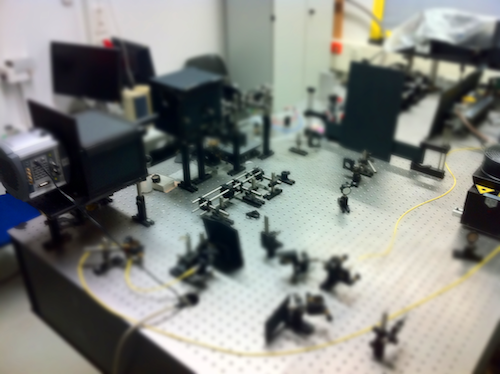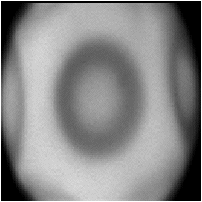Photonic Crystals
 Photonic crystals (PCs) are materials where the dielectric constant is varying periodically. These dielectric structures are able to superimpose the scattering waves in such a way that photonic band structures form in a similar way as electronic band structures in common crystals. Thus, many features of electronic band structures such as band gaps can be found. Unlike real crystals, photonic crystals can be designed and structured without any limits. Thus, the dispersion of photons inside the photonic crystal can be shaped in well-defined ways.
Photonic crystals (PCs) are materials where the dielectric constant is varying periodically. These dielectric structures are able to superimpose the scattering waves in such a way that photonic band structures form in a similar way as electronic band structures in common crystals. Thus, many features of electronic band structures such as band gaps can be found. Unlike real crystals, photonic crystals can be designed and structured without any limits. Thus, the dispersion of photons inside the photonic crystal can be shaped in well-defined ways.
Our group is interested in how the propagation of light is modified by a 3-dimensional photonic crystal. For this purpose we employ internal emitters and single chromophores which are studied by fluorescence microscopy techniques developed in the group.
Angle Resolved Emission Microscopy
 The dispersion relation in photonic crystals, i.e. the photonic band structure can be studied by angle resolved transmission and reflection spectroscopy. This is in general done by varying the incident and detection angle step by step recording at each position a full spectrum. This method is rather time consuming and requires to couple the incident light into the photonic structure. We have developed a promising method relying on an optical microscopy setup. Our approach collects the emission of a photonic structure. To obtain angular resolved spectra, the back focal plane of the microscopy lens is imaged to a spectrograph. This allows a fast recording of the photonic band structure symmetry and a detection of defects in the crystal.
The dispersion relation in photonic crystals, i.e. the photonic band structure can be studied by angle resolved transmission and reflection spectroscopy. This is in general done by varying the incident and detection angle step by step recording at each position a full spectrum. This method is rather time consuming and requires to couple the incident light into the photonic structure. We have developed a promising method relying on an optical microscopy setup. Our approach collects the emission of a photonic structure. To obtain angular resolved spectra, the back focal plane of the microscopy lens is imaged to a spectrograph. This allows a fast recording of the photonic band structure symmetry and a detection of defects in the crystal.
Defocused Imaging of Single Emitters in Photonic Crystals
In a photonic crystal the dielectric constant of the material is varying locally, so that the density of states and all the optical properties of PCs are local properties. For this reason there is a need for local measurements, which has not been possible so far. Our idea is to use single emitters, incorporated into the PC, as local probes and detect the influence of the PC on their emission. Their emission wavelength is inside the stop band of the PC.
To take into account that our PCs possess a band gap for certain directions only, a new value, the FLDoS (Fractional Local Density of States), is introduced [1]. It describes the angular dependence of the optical density of states at a certain wavelength. The fluorescence of single quantum dots (QDs) is detected with a home-built widefield microscope. However, when focusing on a single emitter we only see the point spread function from which one cannot obtain any information about the angular dependence of the QDs emission. To gain this, we use a technique called defocused imaging. It was developed to determine the orientation of molecules or QDs on a substrate [2], because this technique makes it possible to observe the anisotropy of emission which is inherent to those emitters. Our idea is that defocused imaging will enable us to also observe an additional anisotropy which is induced by a photonic crystal [3].
[1] M. Barth, A. Gruber, F. Cichos: Spectral and Angular Redistribution of Photoluminescence near a Photonic Stop Band, Phys. Rev. B. 72, 085129 (2005)
[2] M. Böhmer, J. Enderlein: Orientational Imaging of Single Molecules by Wide-field Epifluorescence Microscopy, J. Opt. Soc. Am. B 20, 554–559 (2003)
[3] M. Barth, R. Schuster, A. Gruber, F. Cichos: Imaging Single Quantum Dots in Three-dimensional Photonic Crystals, Phys. Rev. Lett. 96, 243902 (2006)
Single Quantum Dots
 Semiconductor nanocrystals are efficient and tunable light sources due to quantum size effects. One of their surprising and still puzzling properties can be observed on a single particle level. This is the so called blinking – a random switching behavior between an emitting an non-emitting state. It is the aim of the group’s research to characterize the photophysical properties of quantum dots and to control their light emission, especially their blinking behavior.
Semiconductor nanocrystals are efficient and tunable light sources due to quantum size effects. One of their surprising and still puzzling properties can be observed on a single particle level. This is the so called blinking – a random switching behavior between an emitting an non-emitting state. It is the aim of the group’s research to characterize the photophysical properties of quantum dots and to control their light emission, especially their blinking behavior.
Dynamics of Colloidal Quantum Dots in Electric Fields
 The emission intermittency of single quantum dots is supposed to be related to Auger effects in the quantum dot core. These Auger effects involve the transfer excitation energy from a generated exciton to a free charge in the core. This requires that the two charges of an exciton are eventually separated to leave a charged quantum dot behind. We study the charge state of colloidal quantum dots in nonpolar solvents by recording their migration in external electric fields.
The emission intermittency of single quantum dots is supposed to be related to Auger effects in the quantum dot core. These Auger effects involve the transfer excitation energy from a generated exciton to a free charge in the core. This requires that the two charges of an exciton are eventually separated to leave a charged quantum dot behind. We study the charge state of colloidal quantum dots in nonpolar solvents by recording their migration in external electric fields.
